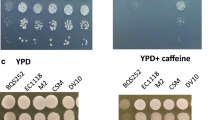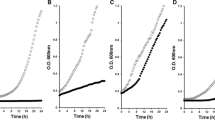Abstract
Nutritional homeostasis is fundamental for alcoholic fermentation in Saccharomyces cerevisiae. Carbon and nitrogen have been related to this metabolic process; nevertheless, little is known about their interactions with the media and the energetic metabolism. Rim15p kinase is a point of convergence among different nutrient-activated signaling pathways; this makes it a target to investigate the relationship between nutritional status and energetic metabolism. To improve the current knowledge of nutrient interactions and their association with RIM15, we validated the doubling time as an indicator of growth phenotype, confirming that this kinetic parameter can be related to the cellular bioenergetic status. This endorses the usefulness of a threshold in doubling time values as an indicator of fermentative (≤ 6.5 h) and respiratory growth (≥ 13.2 h). Using the doubling time as response variable, we find that (i) two second-order interactions between type and concentration of carbon and nitrogen sources significantly affected the growth phenotype of S. cerevisiae; (ii) these metabolic interactions changed when RIM15 was deleted, suggesting a dependence on this gene; (iii) high concentration of ammonium (5% w/v) is toxic for S. cerevisiae cells; (iv) proline prompted fermentative growth phenotype regardless presence or absence of RIM15; (v) RIM15 deletion reverted ammonium toxicity when cells were grown in glucose (10% w/v); and (vi) RIM15 deletion improves fermentative metabolism probably by a partial inhibition of the respiration capacity. This study reveals the existence of synergic and diverse roles of carbon and nitrogen sources that are affected by RIM15, influencing the fermentative and respiratory growth of S. cerevisiae.









Similar content being viewed by others
References
Abernathy DG, Spedding G, Starcher B (2009) Analysis of protein and total usable nitrogen in beer and wine using a microwell ninhydrin assay. J Inst Brew 115:122–127
Alberghina L, Mavelli G, Drovandi G, Palumbo P, Pessina S, Tripodi F, Coccetti P, Vanoni M (2012) Cell growth and cell cycle in Saccharomyces cerevisiae: basic regulatory design and protein–protein interaction network. Biotechnol Adv 30:52–72
Albers E, Larsson C, Lidén G, Niklasson C, Gustafsson L (1996) Influence of the nitrogen source on Saccharomyces cerevisiae anaerobic growth and product formation. Appl Environ Microbiol 62:3187–3195
Batista AS, Miletti LC, Stambuk BU (2005) Sucrose fermentation by Saccharomyces cerevisiae lacking hexose transport. J Mol Microbiol Biotechnol 8:26–33
Berthels N, Corderootero R, Bauer F, Thevelein J, Pretorius I (2004) Discrepancy in glucose and fructose utilisation during fermentation by wine yeast strains. FEMS Yeast Res 4:683–689
Bertram PG, Choi JH, Carvalho J, Chan T-F, Ai W, Zheng XFS (2002) Convergence of TOR-nitrogen and Snf1-glucose signaling pathways onto Gln3. Mol Cell Biol 22:1246–1252
Bokulich NA, Bamforth CW (2013) The microbiology of malting and brewing. Microbiol Mol Biol Rev 77:157–172
Brand MD, Nicholls DG (2011) Assessing mitochondrial dysfunction in cells. Biochem J 435:297–312
Brandriss MC, Magasanik B (1979) Genetics and physiology of proline utilization in Saccharomyces cerevisiae: enzyme induction by proline. J Bacteriol 140:498–503
Brice C, Sanchez I, Bigey F, Legras J-L, Blondin B (2014) A genetic approach of wine yeast fermentation capacity in nitrogen-starvation reveals the key role of nitrogen signaling. BMC Genomics 15:495
van den Brink J, Canelas AB, van GWM, Pronk JT, Heijnen JJ, de WJH, Daran-Lapujade P (2008) Dynamics of glycolytic regulation during adaptation of Saccharomyces cerevisiae to fermentative metabolism. Appl Environ Microbiol 74:5710–5723
Clement T, Perez M, Mouret JR, Sanchez I, Sablayrolles JM, Camarasa C (2013) Metabolic responses of Saccharomyces cerevisiae to valine and ammonium pulses during four-stage continuous wine fermentations. Appl Environ Microbiol 79:2749–2758
Conrad M, Schothorst J, Kankipati HN, Zeebroeck GV, Rubio-Texeira M, Thevelein JM (2014) Nutrient sensing and signaling in the yeast Saccharomyces cerevisiae. FEMS Microbiol Rev 38:254–299
Cooper TG (1982) Nitrogen metabolism in Saccharomyces cerevisiae. Cold Spring Harb Monogr Arch 11:39–99
Crabtree HG (1929) Observations on the carbohydrate metabolism of tumours. Biochem J 23:536–545
Crauwels M, Donaton MC, Pernambuco MB, Winderickx J, de Winde JH, Thevelein JM (1997) The Sch9 protein kinase in the yeast Saccharomyces cerevisiae controls cAPK activity and is required for nitrogen activation of the fermentable-growth-medium-induced (FGM) pathway. Microbiology 143:2627–2637
Cruz SH, Cilli EM, Ernandes JR (2002) Structural complexity of the nitrogen source and influence on yeast growth and fermentation. J Inst Brew 108:54–61
Daran-Lapujade P, Rossell S, van Gulik WM, Luttik MA, de Groot MJ, Slijper M, Heck AJ, Daran JM, de Winde JH, Westerhoff HV, Pronk JT, Bakker BM (2007) The fluxes through glycolytic enzymes in Saccharomyces cerevisiae are predominantly regulated at posttranscriptional levels. Proc Natl Acad Sci U S A 104:15753-15758
Dashko S, Zhou N, Compagno C, Piškur J (2014) Why, when, and how did yeast evolve alcoholic fermentation? FEMS Yeast Res 14:826–832
De Deken RH (1966) The Crabtree effect: a regulatory system in yeast. Microbiology 44:149–156
Desler C, Hansen TL, Frederiksen JB, Marcker ML, Singh KK, Juel Rasmussen L (2012) Is there a link between mitochondrial reserve respiratory capacity and aging? J Aging Res 2012:1–9
Estruch F (2000) Stress-controlled transcription factors, stress-induced genes and stress tolerance in budding yeast. FEMS Microbiol Rev 24:469–486
Fendt S-M, Sauer U (2010) Transcriptional regulation of respiration in yeast metabolizing differently repressive carbon substrates. BMC Syst Biol 4(1):12
Galdieri L, Mehrotra S, Yu S, Vancura A (2010) Transcriptional regulation in yeast during diauxic shift and stationary phase. OMICS J Integr Biol 14:629–638
Godard P, Urrestarazu A, Vissers S, Kontos K, Bontempi G, van Helden J, Andre B (2007) Effect of 21 different nitrogen sources on global gene expression in the yeast Saccharomyces cerevisiae. Mol Cell Biol 27:3065–3086
Hagman A, Säll T, Piškur J (2014) Analysis of the yeast short-term Crabtree effect and its origin. FEBS J 281:4805–4814
Hess DC, Lu W, Rabinowitz JD, Botstein D (2006) Ammonium toxicity and potassium limitation in yeast. PLoS Biol 4:e351
Ibsen H (1961) The Crabtree effect: a review. Cancer Res 21:829–841
Jiranek V, Langridge P, Henschke PA (1995) Amino acid and ammonium utilization by Saccharomyces cerevisiae wine yeasts from a chemically defined medium. Am J Enol Vitic 46:75–83
Kemsawasd V, Viana T, Ardö Y, Arneborg N (2015) Influence of nitrogen sources on growth and fermentation performance of different wine yeast species during alcoholic fermentation. Appl Microbiol Biotechnol 99:10191–10207
Kessi-Pérez EI, Araos S, García V, Salinas F, Abarca V, Larrondo LF, Martínez C, Cubillos FA (2016) RIM15 antagonistic pleiotropy is responsible for differences in fermentation and stress response kinetics in budding yeast. FEMS Yeast Res 16:fow021
Ljungdahl PO, Daignan-Fornier B (2012) Regulation of amino acid, nucleotide, and phosphate metabolism in Saccharomyces cerevisiae. Genetics 190:885–929
Madrigal-Perez LA, Nava GM, González-Hernández JC, Canizal-Garcia M, Ramos-Gomez M (2015) Resveratrol increases glycolytic flux in Saccharomyces cerevisiae via a SNF1-dependet mechanism. J Bioenerg Biomembr 47:331–336
Madrigal-Perez LA, Canizal-Garcia M, González-Hernández JC, Reynoso-Camacho R, Nava GM, Ramos-Gomez M (2016) Energy-dependent effects of resveratrol in Saccharomyces cerevisiae. Yeast 33:227–234
Magasanik B (2003) Ammonia assimilation by Saccharomyces cerevisiae. Eukaryot Cell 2:827–829
Marques WL, Raghavendran V, Stambuk BU, Gombert AK (2016) Sucrose and Saccharomyces cerevisiae: a relationship most sweet. FEMS Yeast Res 16:fov107
Marsit S, Mena A, Bigey F, Sauvage F-X, Couloux A, Guy J, Legras J-L, Barrio E, Dequin S, Galeote V (2015) Evolutionary advantage conferred by an eukaryote-to-eukaryote gene transfer event in wine yeasts. Mol. Biol. Evol. 32:1695–1707
Martínez-Moreno R, Morales P, Gonzalez R, Mas A, Beltran G (2012) Biomass production and alcoholic fermentation performance of Saccharomyces cerevisiae as a function of nitrogen source. FEMS Yeast Res 12:477–485
Mendes-Ferreira A, Mendes-Faia A, Leão C (2004) Growth and fermentation patterns of Saccharomyces cerevisiae under different ammonium concentrations and its implications in winemaking industry. J Appl Microbiol 97:540–545
Nicholls DG, Ferguson SJ (2013) Bioenergetics. Academic Press, London, 434 p
Oomuro M, Kato T, Zhou Y, Watanabe D, Motoyama Y, Yamagishi H, Akao T, Aizawa M (2016) Defective quiescence entry promotes the fermentation performance of bottom-fermenting brewer’s yeast. J Biosci Bioeng 122:577–582
Otterstedt K, Larsson C, Bill RM, Ståhlberg A, Boles E, Hohmann S, Gustafsson L (2004) Switching the mode of metabolism in the yeast Saccharomyces cerevisiae. EMBO Rep 5:532–537
Pedruzzi I, Bürckert N, Egger P, De Virgilio C (2000) Saccharomyces cerevisiae Ras/cAMP pathway controls post-diauxic shift element-dependent transcription through the zinc finger protein Gis1. EMBO J 19:2569–2579
Piškur J, Rozpędowska E, Polakova S, Merico A, Compagno C (2006) How did Saccharomyces evolve to become a good brewer? Trends Genet 22:183–186
Pfeiffer T, Morley A (2014) An evolutionary perspective on the Crabtree effect. Front Mol Biosci 1:17
Rollero S, Bloem A, Camarasa C, Sanchez I, Ortiz-Julien A, Sablayrolles J-M, Dequin S, Mouret J-R (2014) Combined effects of nutrients and temperature on the production of fermentative aromas by Saccharomyces cerevisiae during wine fermentation. Appl Microbiol Biotechnol 99:2291–2304
Stambuk BU, Batista AU, De Araujo PS (2000) Kinetics of active sucrose transport in Saccharomyces cerevisiae. J Biosci Bioeng 89(2):212–214
Swinnen E, Wanke V, Roosen J, Smets B, Dubouloz F, Pedruzzi I, Cameroni E, De Virgilio C, Winderickx J (2006) Rim15 and the crossroads of nutrient signalling pathways in Saccharomyces cerevisiae. Cell Div 1:3
Takagi H, Taguchi J, Kaino T (2016) Proline accumulation protects Saccharomyces cerevisiae cells in the stationary phase from ethanol stress by reducing reactive oxygen species levels: proline protects yeast cells from ethanol by reducing ROS levels. Yeast 33:355–363
Ter Linde JJ, Steensma HY (2002) A microarray-assisted screen for potential Hap1 and Rox1 target genes in Saccharomyces cerevisiae. Yeast 19:825–840
Tesnière C, Delobel P, Pradal M, Blondin B (2013) Impact of nutrient imbalance on wine alcoholic fermentations: nitrogen excess enhances yeast cell death in lipid-limited must. PLoS One 8:e61645
Thevelein JM (1994) Signal transduction in yeast. Yeast 10:1753–1790
Varela C, Pizarro F, Agosin E (2004) Biomass content governs fermentation rate in nitrogen-deficient wine musts. Appl Environ Microbiol 70:3392–3400
Watanabe D, Zhou Y, Hirata A, Sugimoto Y, Takagi K, Akao T, Ohya Y, Takagi H, Shimoi H (2015) Inhibitory role of greatwall-like protein kinase Rim15p in alcoholic fermentation via upregulating the UDP-glucose synthesis pathway in Saccharomyces cerevisiae. Appl Environ Microbiol AEM 02977-15
Watanabe D, Kaneko A, Sugimoto Y, Ohnuki S, Takagi H, Ohya Y (2017) Promoter engineering of the Saccharomyces cerevisiae RIM15 gene for improvement of alcoholic fermentation rates under stress conditions. J Biosci Bioeng 123:183–189
Wood IP, Elliston A, Ryden P, Bancroft I, Roberts IN, Waldron KW (2012) Rapid quantification of reducing sugars in biomass hydrolysates: improving the speed and precision of the dinitrosalicylic acid assay. Biomass Bioenergy 44:117–121
Wu JCF, Hamada MS. 2009. Experiments: planning, analysis, and optimization. 2nd ed. Wiley
Yoboue ED, Mougeolle A, Kaiser L, Averet N, Rigoulet M, Devin A. 2014. The role of mitochondrial biogenesis and ROS in the control of energy supply in proliferating cells. Biochim. Biophys. Acta BBA-Bioenerg. 1837. 18th European Bioenergetics Conference 2014 Lisbon, Portugal: 1093–1098
Zaman S, Lippman SI, Zhao X, Broach JR (2008) How Saccharomyces responds to nutrients. Annu Rev Genet 42:27–81
Acknowledgements
The authors thank Sofia Maria Arvizu-Medrano for the facilities on the use of the BioScreen machine, Eduardo Castaño-Tostado for his assistance with the JMP software analyses, Maria José Armenta-Cardenas for her assistance with kinetic experiments, and Lina Raquel Riego Ruiz for her thoughtful comments on the project.
Funding
This project was supported by grants of the Consejo Nacional de Ciencia y Tecnología (grant number 293940) and Fundación TELMEX-TELCEL (grant number 162005585), both to IKOM. Universidad Autónoma de Querétaro partially funded this work by Fondo de Proyectos Especiales de Rectoría (FOPER) (project number 239471) to IKOM.
Author information
Authors and Affiliations
Corresponding author
Ethics declarations
Conflict of interest
The authors declare that they have no conflicts of interest.
Ethical approval
This article does not contain any studies with human participants or animals performed by any of the authors.
Electronic supplementary material
ESM 1
(PDF 934 kb)
Rights and permissions
About this article
Cite this article
Olivares-Marin, I.K., Madrigal-Perez, L.A., Canizal-Garcia, M. et al. Interactions between carbon and nitrogen sources depend on RIM15 and determine fermentative or respiratory growth in Saccharomyces cerevisiae. Appl Microbiol Biotechnol 102, 4535–4548 (2018). https://doi.org/10.1007/s00253-018-8951-3
Received:
Revised:
Accepted:
Published:
Issue Date:
DOI: https://doi.org/10.1007/s00253-018-8951-3




